
Table of Contents (Start)
- Topics
- Introducing SevOne
- Login
- Startup Wizard
- Dashboard
- Global Search - Advanced Search
- Report Manager
- Report Attachment Wizard
- Report Properties
- Report Interactions
- Instant Graphs
- TopN Reports
- Alerts
- Alert Archives
- Alert Summary
- Instant Status
- Status Map Manager
- Edit Maps
- View Maps
- FlowFalcon Reports
- NBAR Reports
- Logged Traps
- Unknown Traps
- Trap Event Editor
- Trap Destinations
- Trap Destination Associations
- Policy Browser
- Create and Edit Policies
- Webhook Definition Manager
- Threshold Browser
- Create and Edit Thresholds
- Probe Manager
- Discovery Manager
- Device Manager
- New Device
- Edit Device
- Object Manager
- High Frequency Poller
- Device Summary
- Device Mover
- Device Groups
- Object Groups
- Object Summary
- Object Rules
- VMware Browser
- AWS Plugin
- Azure Plugin (Public Preview)
- Calculation Plugin
- Database Manager
- Deferred Data Plugin
- DNS Plugin
- HTTP Plugin
- ICMP Plugin
- IP SLA Plugin
- JMX Plugin
- NAM
- NBAR Plugin
- Portshaker Plugin
- Process Plugin
- Proxy Ping Plugin
- SDWAN Plugin
- SNMP Plugin
- VMware Plugin
- Web Status Plugin
- WMI Plugin
- xStats Plugin
- Indicator Type Maps
- Device Types
- Object Types
- Object Subtype Manager
- Calculation Editor
- xStats Source Manager
- User Role Manager
- User Manager
- Session Manager
- Authentication Settings
- Preferences
- Cluster Manager
- Maintenance Windows
- Processes and Logs
- Metadata Schema
- Baseline Manager
- FlowFalcon View Editor
- Map Flow Objects
- FlowFalcon Views
- Flow Rules
- Flow Interface Manager
- MPLS Flow Mapping
- Network Segment Manager
- Flow Protocols and Services
- xStats Log Viewer
- SNMP Walk
- SNMP OID Browser
- MIB Manager
- Work Hours
- Administrative Messages
- Enable Flow Technologies
- Enable JMX
- Enable NBAR
- Enable SNMP
- Enable Web Status
- Enable WMI
- IP SLA
- SNMP
- SevOne Data Publisher
- Quality of Service
- Perl Regular Expressions
- Trap Revisions
- Integrate SevOne NMS With Other Applications
- Email Tips and Tricks
- SevOne NMS PHP Statistics
- SevOne NMS Usage Statistics
- Glossary and Concepts
- Map Flow Devices
- Trap v3 Receiver
- Guides
- Quick Start Guides
- AWS Quick Start Guide
- Azure Quick Start Guide (Public Preview)
- Data Miner Quick Start Guide
- Flow Quick Start Guide
- Group Aggregated Indicators Quick Start Guide
- IP SLA Quick Start Guide
- JMX Quick Start Guide
- Metadata Quick Start Guide
- RESTful API Quick Start Guide
- Self-monitoring Quick Start Guide
- SevOne NMS Admin Notifications Quick Start Guide
- SNMP Quick Start Guide
- Synthetic Indicator Types Quick Start Guide
- Topology Quick Start Guide
- VMware Quick Start Guide
- Web Status Quick Start Guide
- WMI Quick Start Guide
- xStats Quick Start Guide
- xStats Adapter - Accedian Vision EMS (TM) Quick Start Guide
- Deployment Guides
- Automated Build / Rebuild (Customer) Instructions
- Generate a Self-Signed Certificate or a Certificate Signing Request
- SevOne Best Practices Guide - Cluster, Peer, and HSA
- SevOne Data Platform Security Guide
- SevOne NMS Implementation Guide
- SevOne NMS Installation Guide - Virtual Appliance
- SevOne NMS Advanced Network Configuration Guide
- SevOne NMS Installation Guide
- SevOne NMS Port Number Requirements Guide
- SevOne NMS Upgrade Process Guide
- SevOne Physical Appliance Pre-Build BIOS and RAID Configuration Guide
- SevOne SAML Single Sign-On Setup Guide
- Cloud Platforms
- Other Guides
- Quick Start Guides
Azure Quick Start Guide (Public Preview)
For SevOne NMS 6.8 release, the Azure Plugin is for Public Preview only.
SevOne Documentation
All documentation is available from the IBM SevOne Support customer portal.
© Copyright International Business Machines Corporation 2024.
All right, title, and interest in and to the software and documentation are and shall remain the exclusive property of IBM and its respective licensors. No part of this document may be reproduced by any means nor modified, decompiled, disassembled, published or distributed, in whole or in part, or translated to any electronic medium or other means without the written consent of IBM.
IN NO EVENT SHALL IBM, ITS SUPPLIERS, NOR ITS LICENSORS BE LIABLE FOR ANY DAMAGES, WHETHER ARISING IN TORT, CONTRACT OR ANY OTHER LEGAL THEORY EVEN IF IBM HAS BEEN ADVISED OF THE POSSIBILITY OF SUCH DAMAGES, AND IBM DISCLAIMS ALL WARRANTIES, CONDITIONS OR OTHER TERMS, EXPRESS OR IMPLIED, STATUTORY OR OTHERWISE, ON SOFTWARE AND DOCUMENTATION FURNISHED HEREUNDER INCLUDING WITHOUT LIMITATION THE WARRANTIES OF DESIGN, MERCHANTABILITY OR FITNESS FOR A PARTICULAR PURPOSE, AND NONINFRINGEMENT.
IBM, the IBM logo, and SevOne are trademarks or registered trademarks of International Business Machines Corporation, in the United States and/or other countries. Other product and service names might be trademarks of IBM or other companies. A current list of IBM trademarks is available on ibm.com/trademark.
About
SevOne's Azure plugin allows you to collect metrics for Virtual Machines and Virtual Machine Scale Sets along with device metadata for each Resource type from an Azure environment. The Azure plugin allows you to monitor multiple different geographies for any given subscription. Multiple integrations can be created on a per subscription basis.
Device Creation
SevOne NMS Azure plugin regularly calls Azure APIs to retrieve information about Virtual Machines and Virtual Machine Scale Sets and then automatically create devices for each Azure resource.
Required Resources in Azure
To monitor an Azure account, the following are necessary.
-
Tenant ID
-
Subscription ID
-
App Registration
App Registration and Client Secret
For the Azure plugin to run, it will need to authenticate with Azure by being registered as an application and using a client secret.
-
To register an application, please navigate to the Azure Portal, https://portal.azure.com.
-
Navigate to the App registrations.
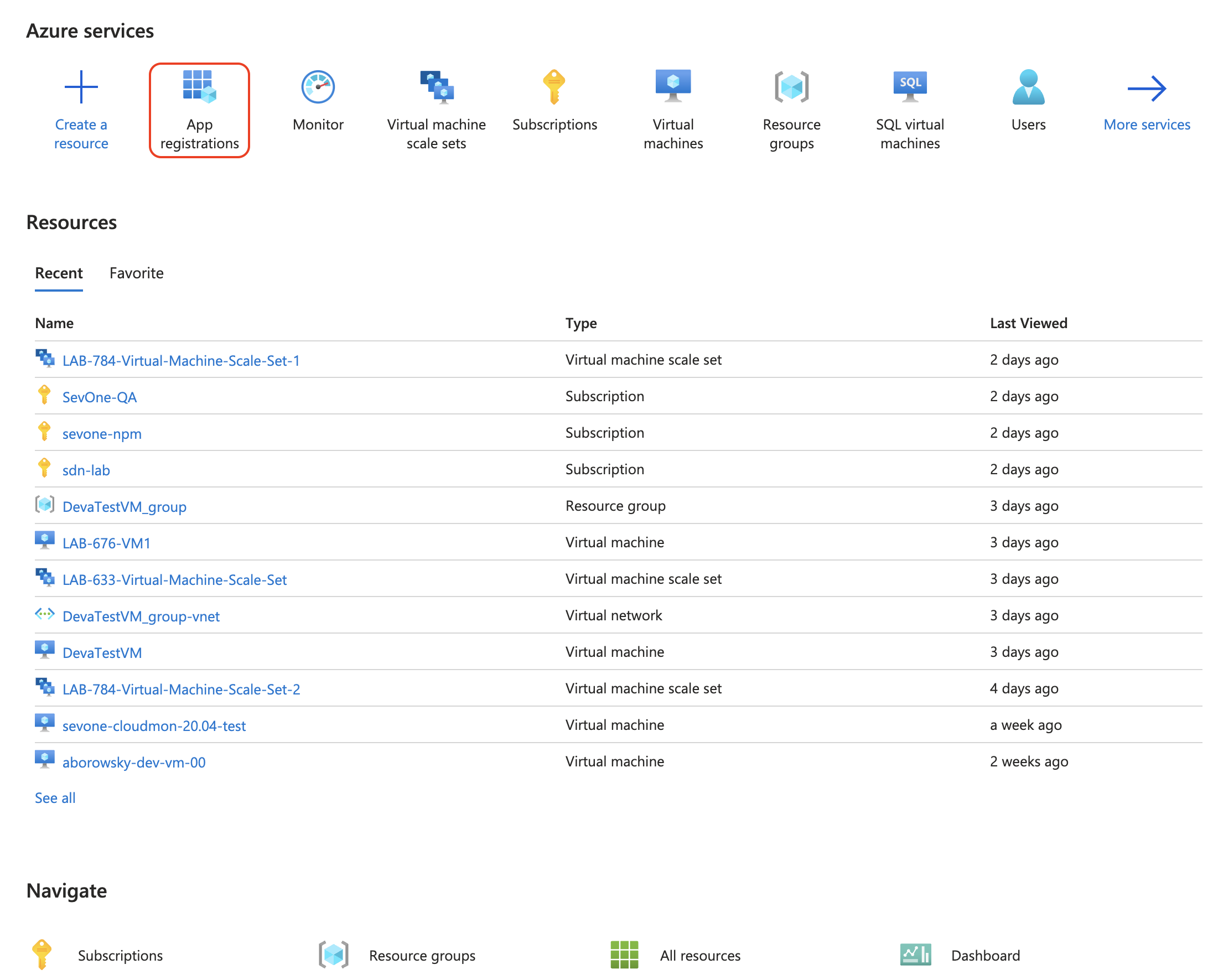
-
Click New registration.
You may need to request your administrator for access to create a new registration.

-
On Register an application page,
-
Name - enter a name. For example, SevOne NPM.
-
Under Supported account types, select check box Accounts in this organizational directory only.
-
Click Register.
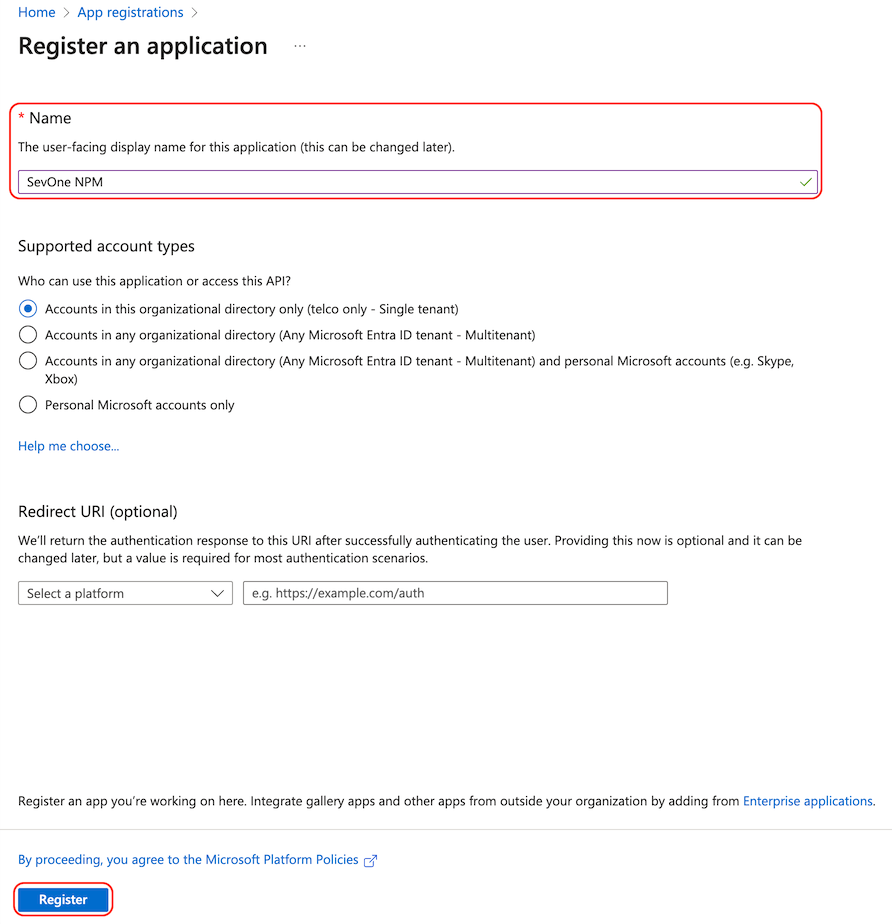
-
-
Once registered, the Azure portal will navigate to the recently registered App.
IMPORTANTRemember to copy and save the values in fields Application (client) ID and Directory (tenant) ID in the right panel. You will need these to start the Azure plugin in SevOne NMS.

-
Click Add a certificate or secret or from the left navigation bar, choose Certificates & secrets.
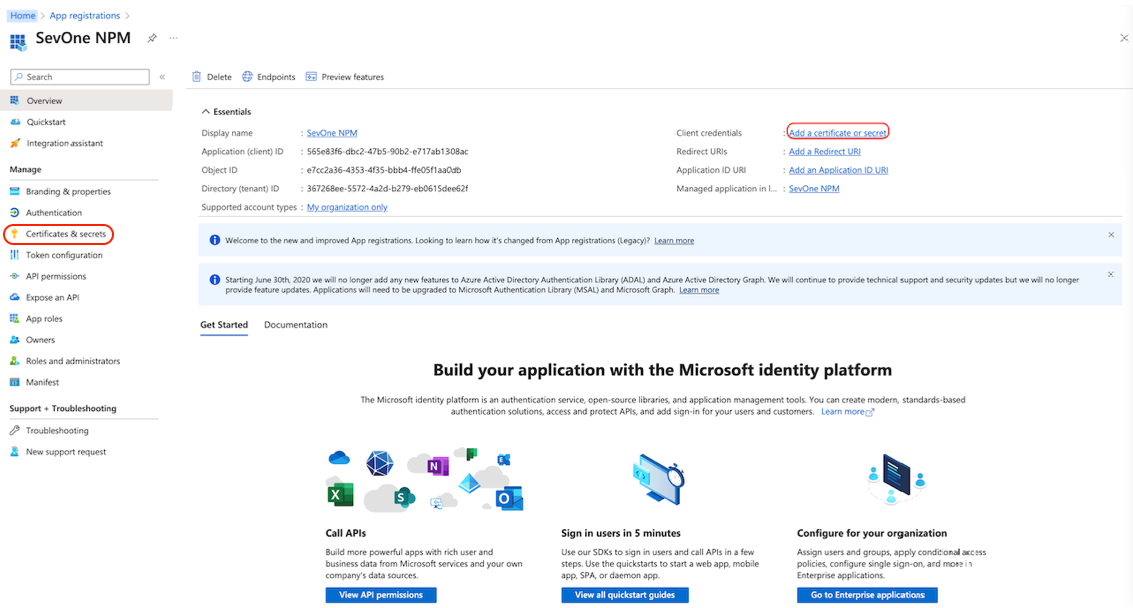
-
Click Client secrets tab in the right panel, and then click New client secret.
-
Description - add a description. For example, Azure NMS Collector secret.
-
Expires - select an expiry date for the secret. The recommended time is 6 months by Azure. For example, 4/24/2024.
This procedure for creating a new client secret will need to be repeated when this secret expires after the selected expiry date.
-
Click Add.
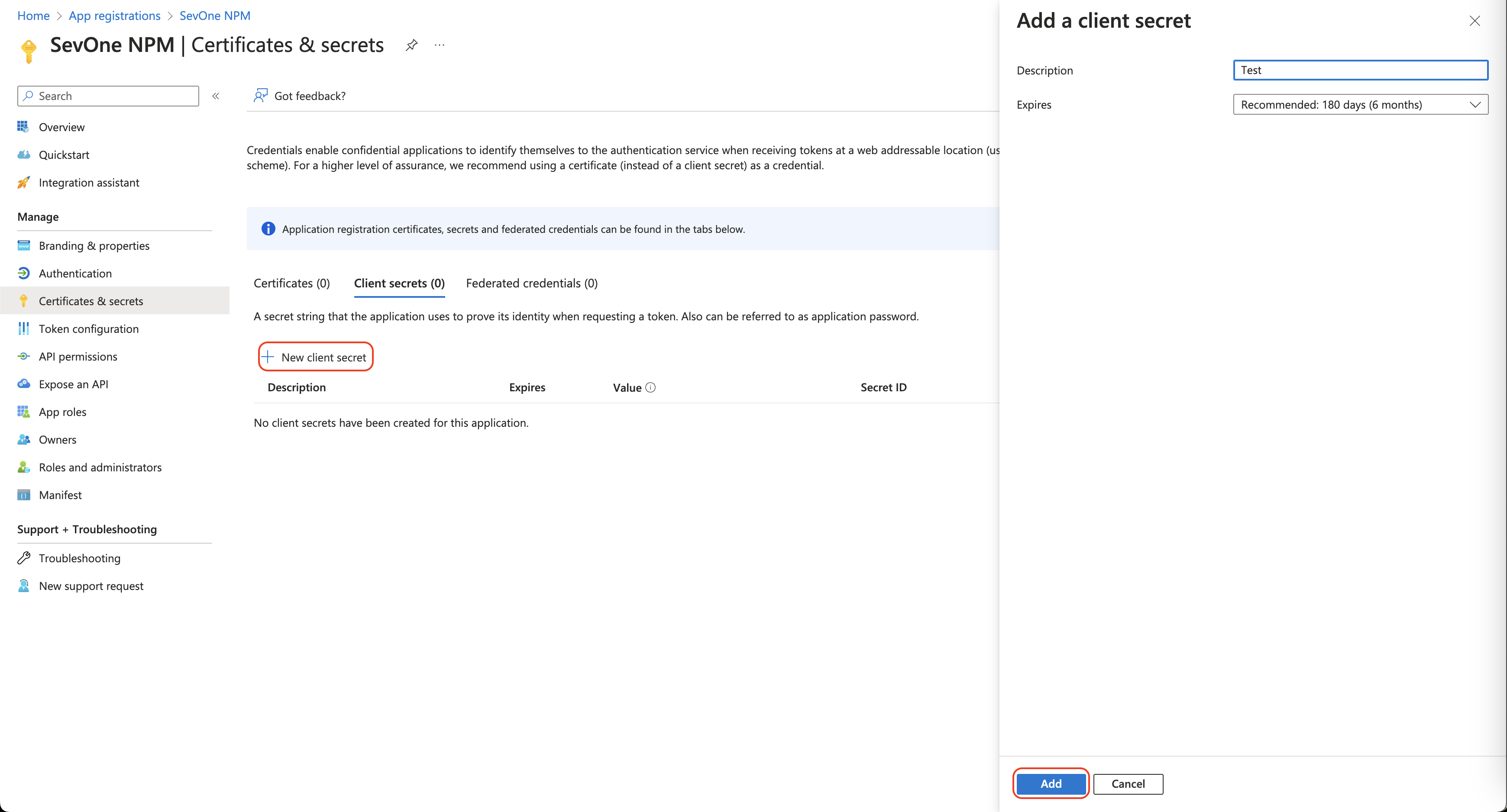
-
-
After the secret is added, you should see the new client secret within the Client secrets tab. The Value field is the client secret that the collector needs to authenticate.
IMPORTANTRemember to copy and save the client secret in field Value. You will need this in SevOne NMS to be able to start the Azure plugin.
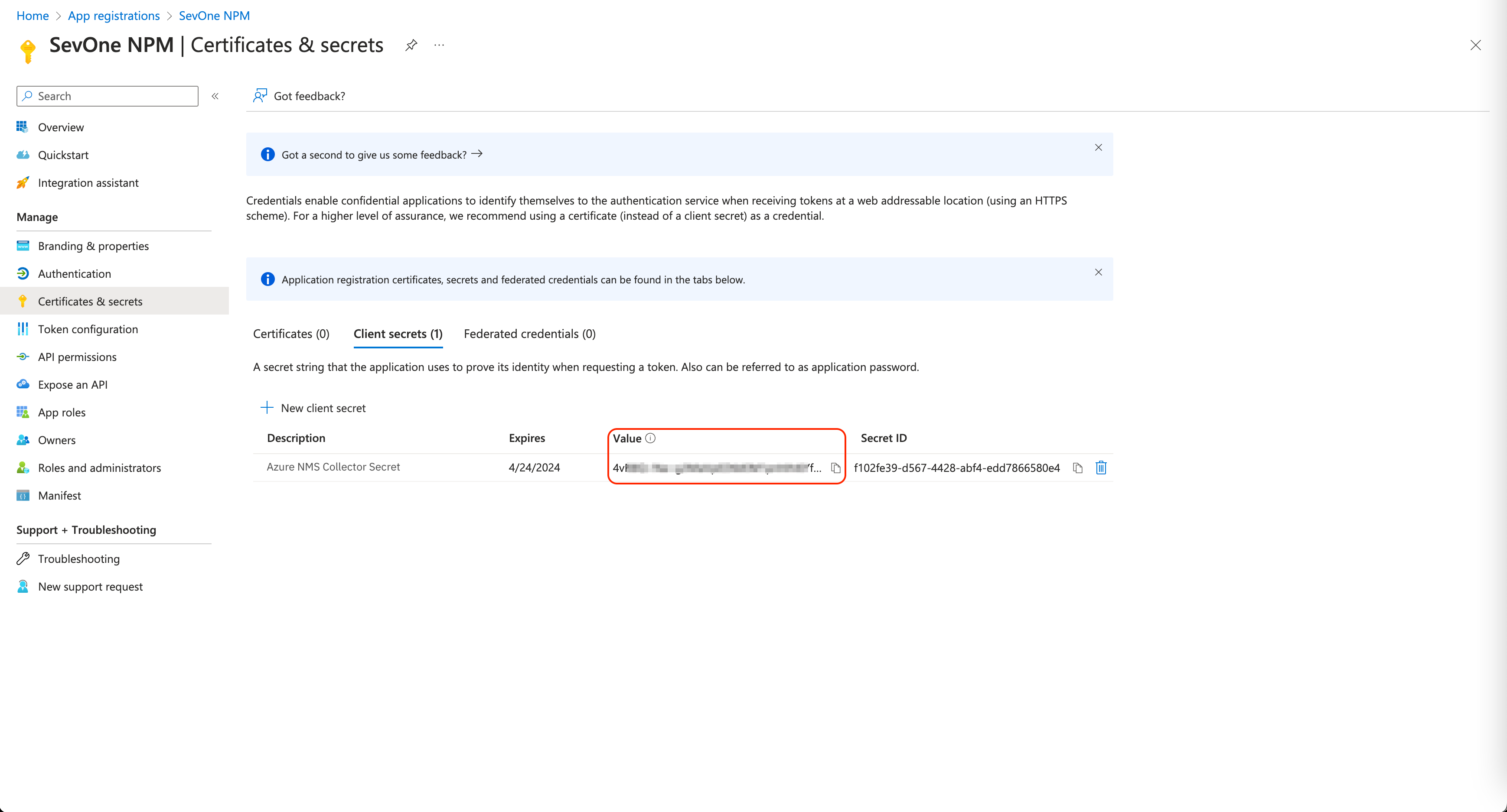
Assign a Role to the App
For the Azure plugin to be able to retrieve the correct information from Azure, it will need to be assigned a role containing all of the permissions that it needs.
-
To assign a role to the application you created in the last section, please navigate to the Azure Portal, https://portal.azure.com.
-
Navigate to Subscriptions.
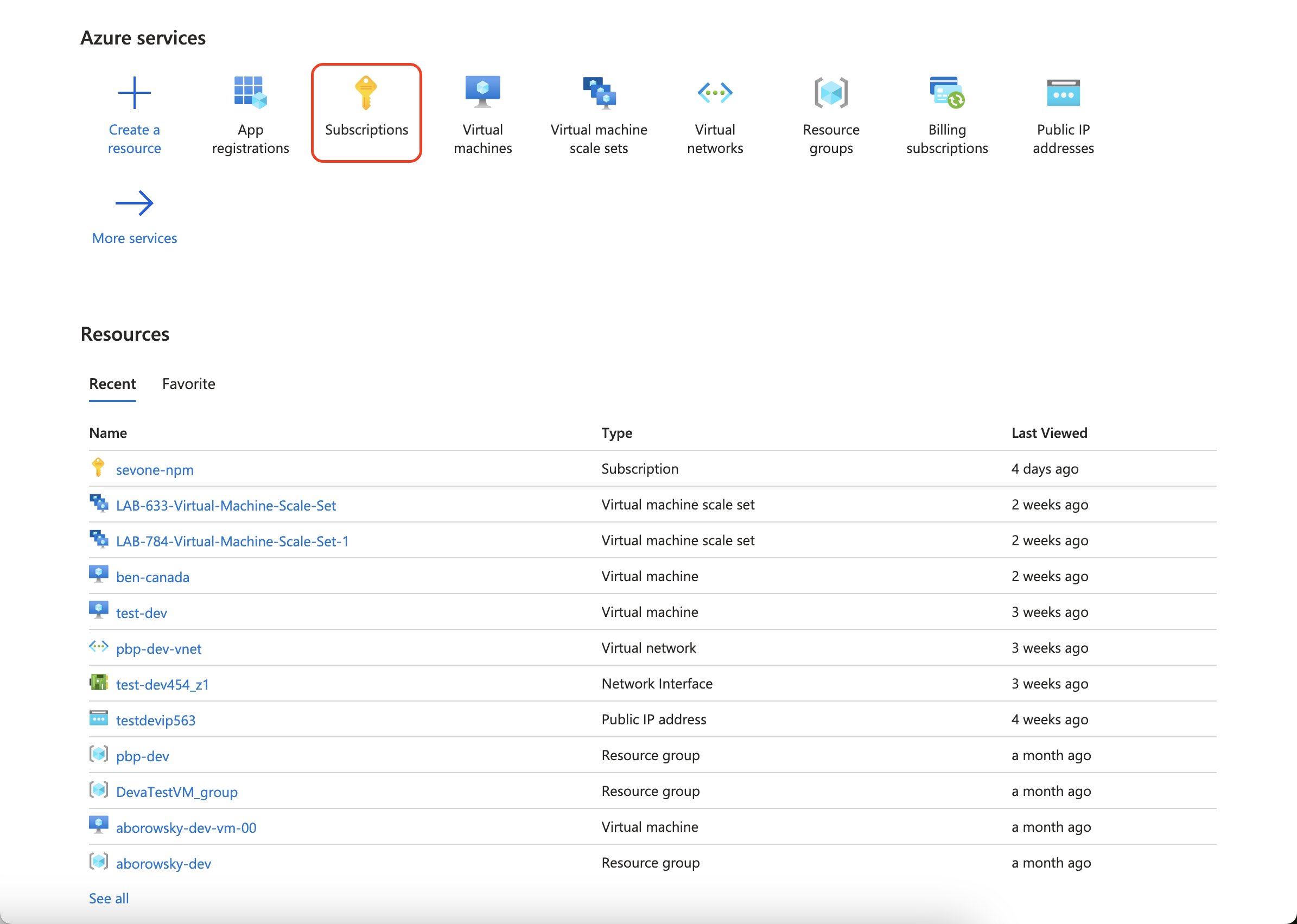
-
Click the name of the subscription that you want to monitor.

-
Click Access control (IAM) on the left navigation bar.
IMPORTANTRemember to copy and save the Subscription ID value in the right pane. You will need this value in order to start the Azure plugin in SevOne NMS.
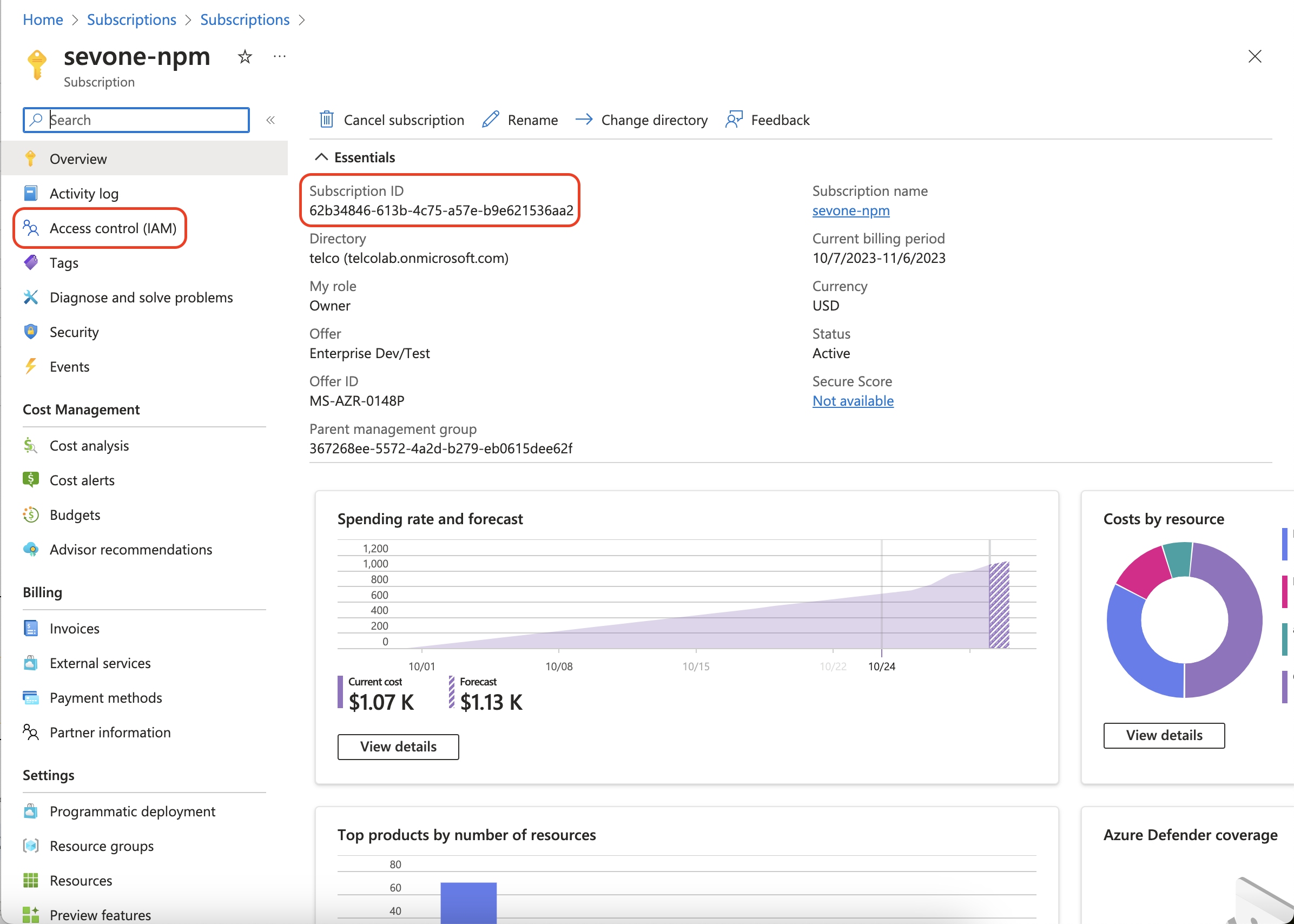
-
Click Add, then click Add role assignment from the dropdown menu.
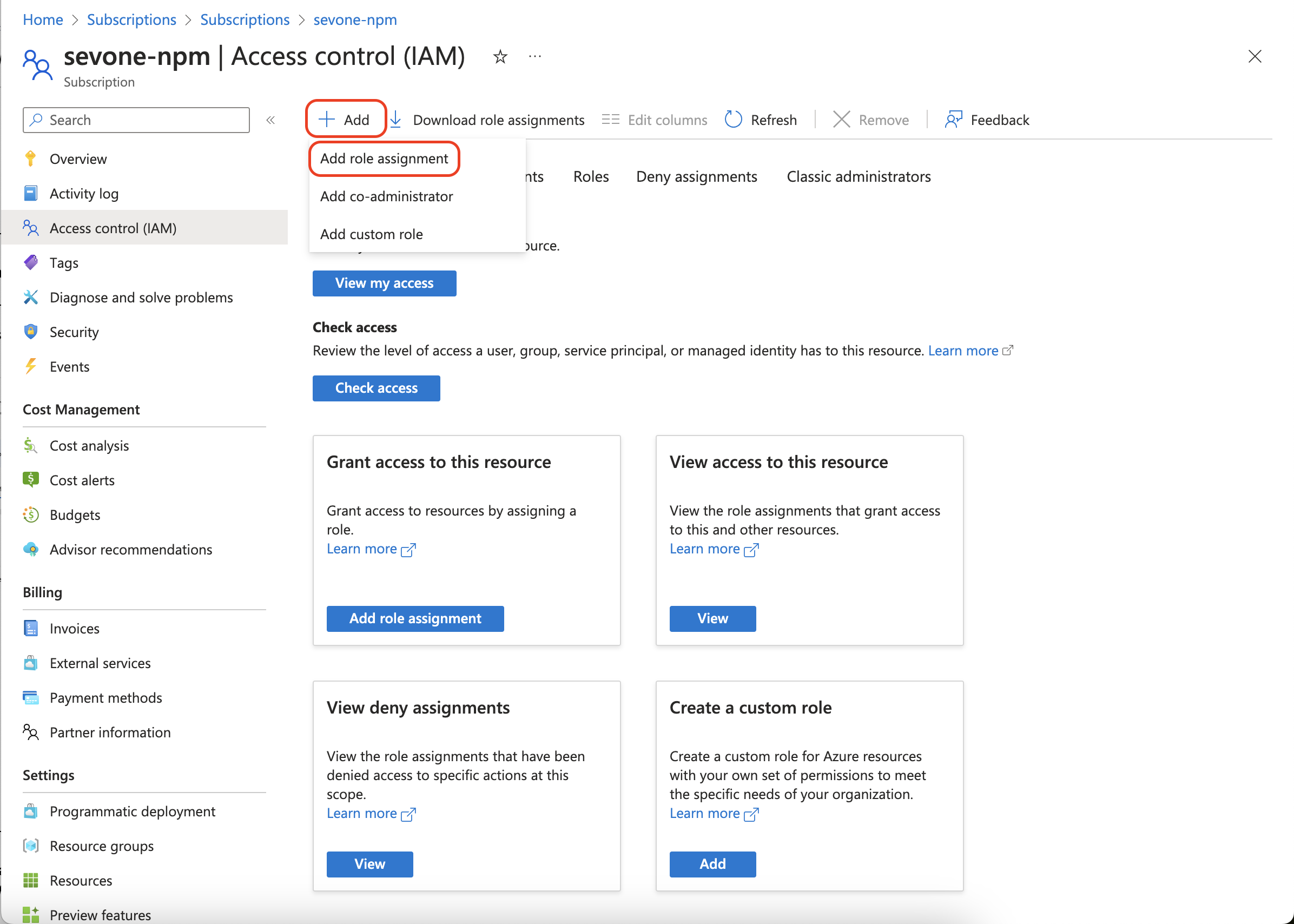
-
In the Add role assignment page > tab Role,
-
Type Monitoring Reader into the search bar.
-
Click the Monitoring Reader entry in the table.
-
Click Next.

-
-
In the Add role assignment page > tab Members,
-
Click Select members.
-
In the Select members panel,
-
Type the name of the app you registered into the Select search bar.
-
Click the correct entry for the app you registered in the results.
-
Click Select.
-
-
Click Next.
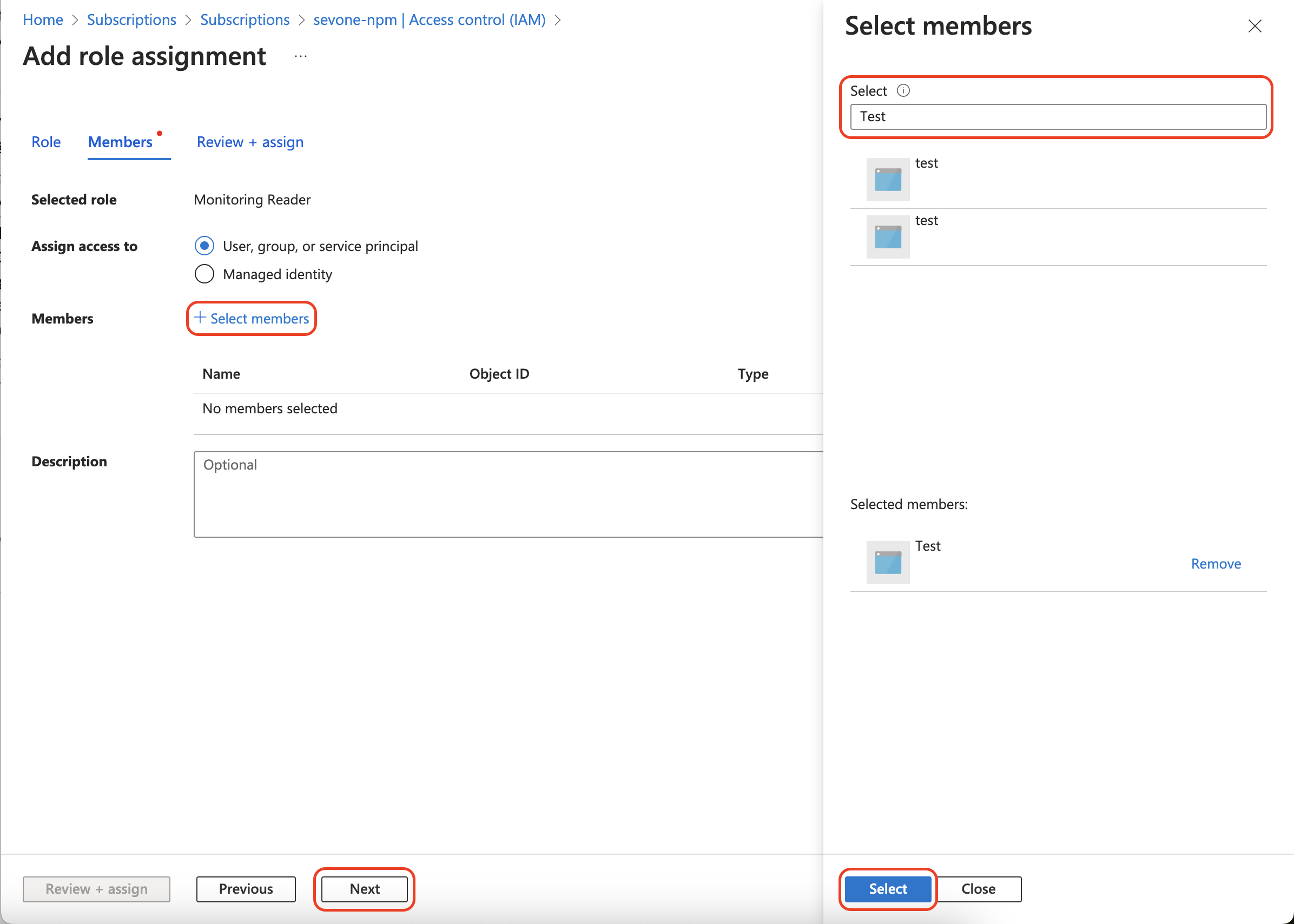
-
-
In the Add role assignment page > tab Review + assign,
-
Review the information on the page to make sure everything is correct.
-
Click Review + assign.
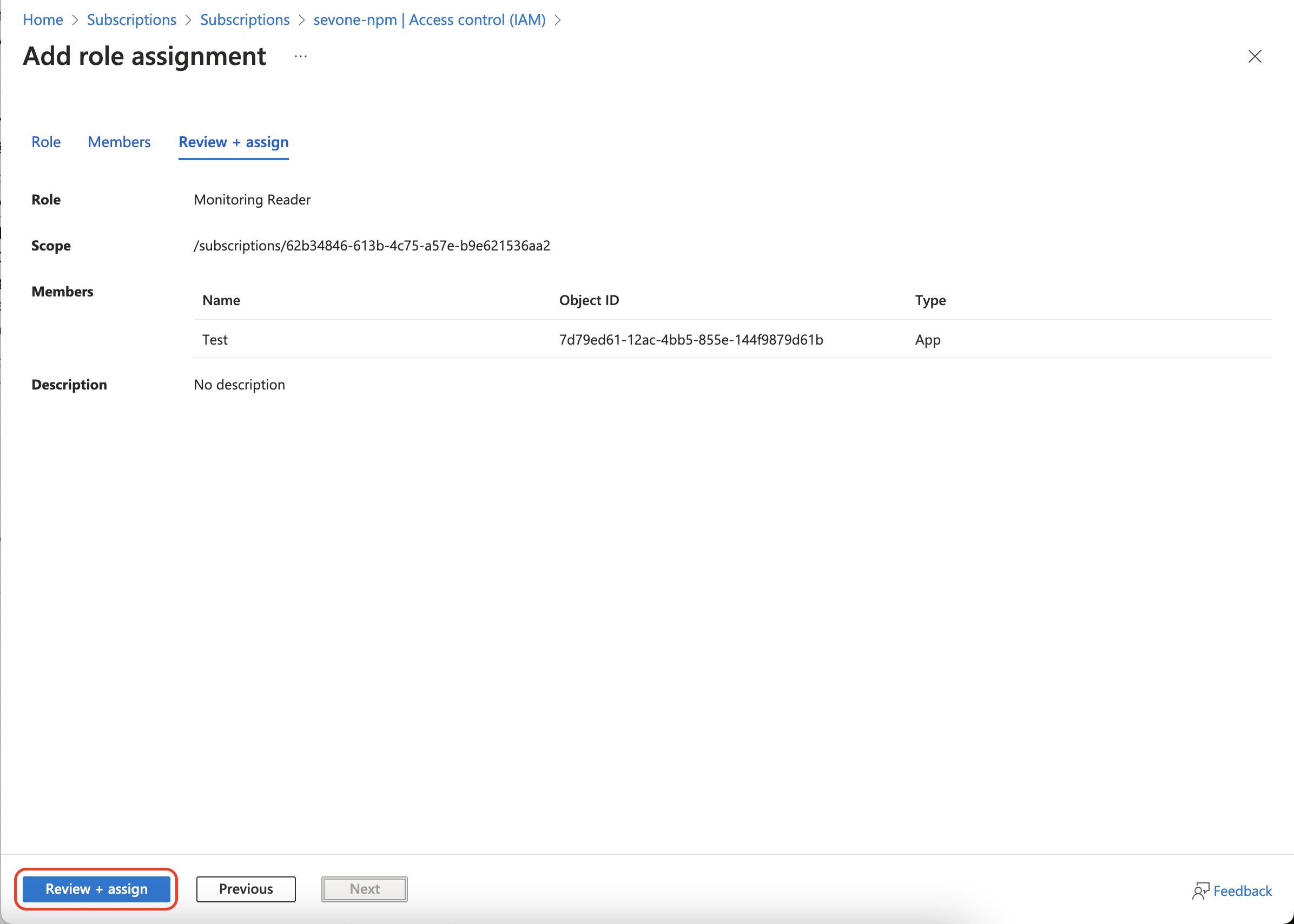
-
Repeat steps 3 – 8 above for each subscription that you want to monitor, taking note of each Subscription ID. It is not necessary to create a new app registration for each subscription.
Enable Azure Plugin
Execute the following steps to monitor an Azure account. This will automatically create devices and collect metrics for various Azure resources within selected regions for that account.
-
To access the Device Manager from the navigation bar, click the Devices menu and select Device Manager.
-
Either add a device with the Azure plugin or edit an existing device to enable the Azure plugin.
-
Click Add Device to display the New Device page.
-
Click the wrench icon under the Actions column to display the Edit Device page.
-
-
Click the plugin drop-down. By default, it is set to SNMP. Select Azure.

-
Select the Enable Azure Integration check box.
-
In the Tenant ID field, enter the ID of the Azure tenant you want to monitor. This is the same as the Directory (tenant) ID value that was noted above.
-
In the Subscription ID field, enter the ID of the Azure subscription you want to monitor. This is the same as the Subscription ID that was noted above.
-
In the Application Client ID field, enter the ID of Azure registered application for SevOne. This is the same as the Application (client) ID value that was noted above.
-
In the Client Secret Value field, enter the value of the secret created for the Azure registered application. This is the same as the value noted in Value above.
-
Click Save As New to save the current changes as a New Device, or click Save to confirm the changes in the Edit Device page.
-
When the desired changes have been saved, click the Cancel button to return to the Device Manager page.
Create TopN View in SevOne NMS to view Azure resources
SevOne NMS contains a package with Azure-specific TopN views. To import, execute the following command.
$ SevOne-import --file /opt/SevOne-aws-collector/topn.spkThe import will fail unless the Azure collector has run successfully at least once.
OOTB Reports
Once the NMS Azure Plugin integration is setup and we see Devices and Objects populate in the Device manager, the following out-of-the-box (OOTB) reports are available in Data insights for you to get insights on your resources.
-
Azure Virtual Machines - report showing Azure Virtual Machine metrics.
-
Azure Virtual Machine Scale Sets - report showing Azure Virtual Machine Scale Set metrics.